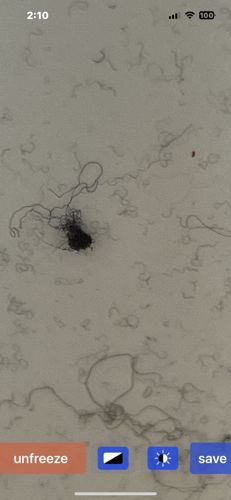Nematode (Roundworm)
Scientific Name: Nematoda (as a phylum, specific species or genus cannot be determined from the image)
Order & Family: Phylum Nematoda (no specific order/family is discernible from the image)
Size: Most free-living nematodes are microscopic, ranging from less than 1 mm to several millimeters in length. Parasitic forms can be larger, with some reaching several centimeters or even a meter in length (e.g., Guinea worm).

Natural Habitat
Nematodes are ubiquitous and found in almost every environment on Earth. They are abundant in soil, freshwater, marine environments, and as parasites within plants and animals (including humans).
Diet & Feeding
Diet varies greatly depending on the species. Free-living nematodes can be bacterivores (feeding on bacteria), fungivores (feeding on fungi), predators (feeding on other nematodes or small organisms), or omnivores. Plant-parasitic nematodes feed on plant roots or other plant tissues. Animal-parasitic nematodes feed on the tissues or fluids of their hosts.
Behavior Patterns
Nematodes move using muscular contractions, which can be seen as wiggling or undulating movements. Many are free-living in soil or water, while others are parasitic. Their life cycle typically involves eggs, several larval stages, and adults. Reproduction varies, with some species being hermaphroditic.
Risks & Benefits
Risks: Many species are significant parasites of humans, livestock, and crops, causing diseases (e.g., ascariasis, filariasis in humans; root-knot disease in plants) and substantial economic losses. Benefits: Free-living nematodes play crucial roles in nutrient cycling and decomposition in soil and aquatic ecosystems. Some species are used as biological control agents against insect pests.
Identified on: 8/29/2025